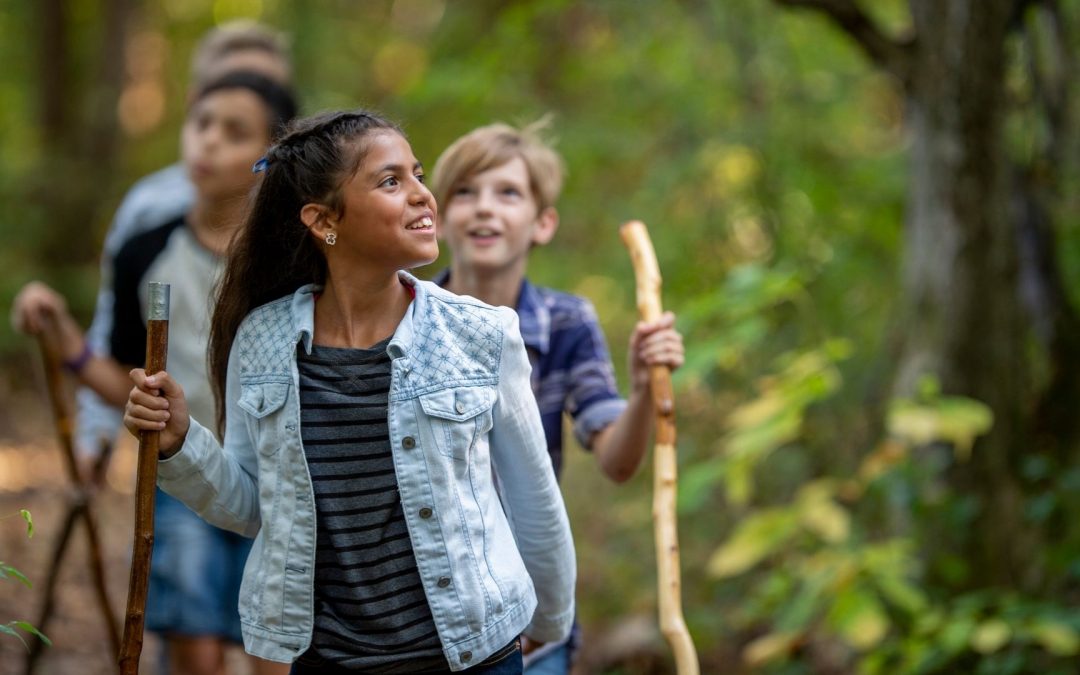Do youth get enough time outdoors? More and more, the answer is becoming “No.” Richard Louv made the case in his book, Last Child in the Woods, that young people were spending so little time in nature that they had “nature deficit disorder.” The consequences they suffered were dire: more stress and anxiety, higher rates of obesity and ADHD, and more.
Young people have few opportunities for free outdoor play. They have limited regular contact with the natural world. Their world has shrunk as we have pushed back their boundaries. A culture of fear has tied young people closer to home. Sometimes youth do not even have free time out in their own yard.
A culture of schedules also adds to the problem. Young people’s time is so structured with school, sports, clubs, music lessons, etc. that there is little free time to play in the outdoors. Youth today no longer have free, unsupervised time to wander and explore the outdoor world.
To make matters worse, the time that youth do get to spend outdoors is not truly time in nature. They are on streets, sidewalks, and parking lots. Even playgrounds are typically asphalt areas with manufactured playground equipment. Young people do not receive enough experiences in the natural world.
The Effect of Nature on Youth
Academics
Research has shown that exposure to nature has positive cognitive, emotional, and physical impacts on youth development. Most adults recognize that time outdoors in nature is good for young people. (For all of us!) However, they may also see a tradeoff. Encouraging youth to spend time outdoors means less time studying and hitting the books. This may mean less academic achievement, right? Actually, the opposite is true! Nature can have profound impacts on young people’s ability to focus and learn.
There is a great deal of research to support this fact. One study compared two sets of fifth graders. One set attended school in a traditional setting. The other students attended schools that were regularly held outdoors with integrated learning and onsite research. The students in the “outside school” had better attendance, higher performance on standardized tests and reported feeling more excited about school. Another study compared students taking science lessons in a classroom with students taking lessons outside. The more time students spent outside, the more achievement they showed.
These benefits were especially true for at-risk students from lower socioeconomic backgrounds. Research has documented race- based and class-based environmental inequality.
Attention
Closely related to academic achievement, time outdoors has also been shown to improve young people’s attention. Many students struggle to maintain attention and focus in the classroom due to ADHD, distractions, or mental fatigue. Spending time in nature, or even taking time to view nature through a window, helps restore attention and allows students to concentrate better.
Engagement
Young people enjoy class time outdoors. However, teachers are often concerned that taking students outdoors will get them excited and “rowdy.” Teachers fear that the students will be hard to calm back down to learn. Research actually shows that students not only are more engaged during outdoor lessons, but also more engaged in learning AFTER being outdoors (when they are back in the classroom.) These benefits occur with lessons in any subject area, not just science and nature.
Stress
Stress is impacting people at younger and younger ages. Luckily, at all ages, nature is a wonderful stress reliever. Studies show that having class outdoors just one day a week can significantly improve the daily cortisol patterns of students and teachers alike. They experienced less stress as compared to classes with only indoor instruction. They were also better able to adapt to any stress they did experience.
Environmental Learning
Time in the natural world is also the best vehicle for environmental learning and environmental responsibility. Without time in nature, young people cannot make a bond with the outdoor world. Researchers call it an “extinction of experience” which leads to apathy toward environmental concerns. “We have become so estranged from our natural origins, we have failed to recognize our basic dependence on nature as a condition of growth and development.”
John Burroughs cautions that “Knowledge without love will not stick, but if love comes first, knowledge is sure to follow.” Young people need to develop a love for their natural world. Only then, will they be interested in discovering knowledge of how to properly care for it. We need to foster young people’s love for the Earth before we ask them to save it.
Self – Discipline
Young people are still developing impulse control. Lack of impulse control can interfere in many areas of life. Having regular access to green spaces near the home has been shown to help youth have more self-discipline.
Physical Activity
Youth outside naturally tend to be more active. They are getting their heart pumping and breathing fresh air. Not only is this physically good for them, but it also supports efficient cognitive processing. This means that young people who are physically fit tend to do better academically.
Relationships
Spending time outdoors builds enhanced relationships between peers as well as between teacher and students, and even within families. The outdoors feels like a calm, socially safe, and fun space that promotes these relationships.
Creativity
Opportunities abound outdoors for youth to explore, take risks, question, experiment, discover, sing, dance, and imagine. These opportunities can all lead to a boost in creativity.
Overall, limited exposure to nature and green space has serious physical and psychological health ramifications. On the other hand, stress relief, improved short-term memory, increased mental energy, less inflammation, better vision, improved concentration, creativity, and improved mental health are just some of the benefits of quality time outdoors in nature. At Jameson Camp we want to help young people “get outside and grow inside.” Our staff has been impacting the lives of young people since 1928 by bringing them into the great outdoors as part of the summer camp programs.
Are you on Facebook? We are, too! Let’s be friends!

